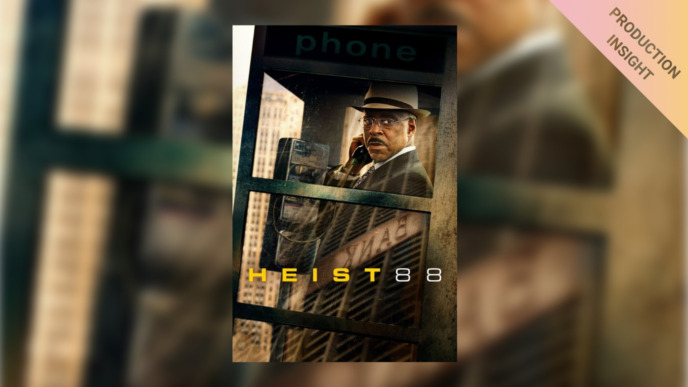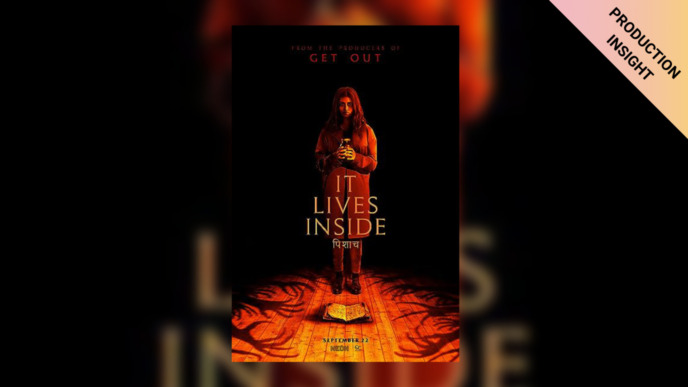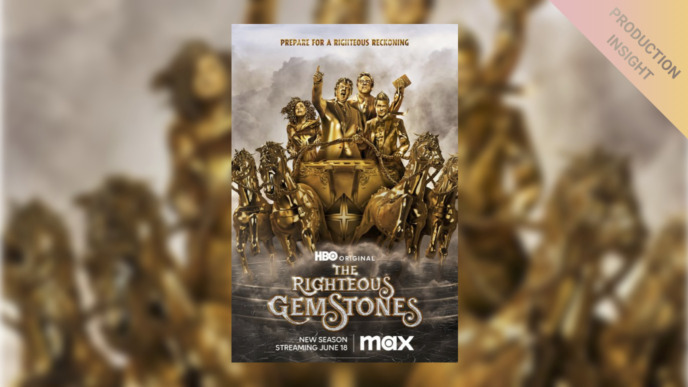
With “Old Henry”, a contemporary representative of a classic American genre premiered at the 2021 Venice Film Festival. The action western, written and directed by Potsy Ponciroli, follows the story of a widowed farmer and his son who take in a mysterious, injured man. With the stranger comes trouble calling the farmer’s true identity into serious question.
In this interview, Cinematographer John Matysiak and Digital Imaging Technician Scotty Wright take us behind the scenes by sharing exclusive insights into their individual work and collaboration.
First, we were, of course, curious to find out how they both ended up on the production’s call sheet. Although John’s and Scotty’s professional paths had briefly crossed before, “Old Henry” was the first feature film that they worked on together in their respective roles. Besides the prospect of working with familiar faces, the film’s genre had a significant appeal as the two explain:
Scotty:
The production supervisor on this film has been a friend and colleague as long as I have been freelancing. She called me about two weeks out from filming, so it was a very quick decision with my partner to leave for six weeks to go film outside of Nashville in the middle of the pandemic. At the same time, filming a western close to home with a bunch of old friends was too good an opportunity to pass up.
I think any chance you have as a cinematographer or filmmaker to be involved in a western you’ve got to take; it’s just such a great kind of playground.
John:
I worked with Potsy on a television show before, but we were always talking about that it would be fun to do a feature together. And then he wrote that western, and he sent it to me, and it was immediately like ‘we’ve got to do this’. I think any chance you have as a cinematographer or filmmaker to be involved in a western you’ve got to take; it’s just such a great kind of playground.
The western genre is a truly American art form. You know, what’s really interesting is that as cinema was just beginning, this genre used some of the actual outlaws from the West. They were involved as screenwriters, advisors, and sometimes even acting in these westerns and kind of defined what that genre was. I find that just fascinating!
So, how do you approach a genre that bears such rich history? John explains his creative intent and goals for the film’s visual language as follows:
John:
The film is so minimal, and we wanted the visual language to represent that. We wanted there to be a heaviness about the frames; we wanted there to be a heaviness about the story. It’s ultimately a film about isolation, and so we kind of knew we wanted to represent that isolation as best as we could. So Potsy and I spoke more about the type of film we wanted to make more than specifics. We never kind of got into the specifics of lighting or framing; we just talked more about what was the type of film we want to make. That’s kind of the short answer.

In order to bring those visions to life, a lot of time was spent prepping on location – a remote settler’s cabin and vast surrounding property in Tennessee. During production, however, said location caused some challenges with the weather switching from rain to snow and bringing at times freezing temperatures. As John recalls, the production thus didn’t just depict an adventure but became one itself:
John:
We had spent a massive amount of time prepping this film, walking the location, shot listing it, and so 90-95% of the film was kind of shot listed ahead of time. So going into production, you’re just trying to do what you can to facilitate those ideas, and those images, and that kind of story.
Still, I think every day was a massive challenge. The property we were shooting at was this large 3000-acre farm. And so I think that’s great because on camera, I feel like it translates beautifully – but from a technical aspect.. You know we were constantly using offroad vehicles to get our stuff where we needed it to be. And there were horses, there were special effects, there were stunt coordinators – you know every single day there would be just this massive amount of stuff we had to do.
A relatively short production time of 21 days further added to the challenge. To realize an ambitious production on a tight schedule and with limited resources, a dedicated crew was key. So, how did John and Scotty envision and approach their collaboration?
John:
Every working relationship is different; every collaboration is different. But for me, what I look for in a DIT is someone who supports what we’re doing and kind of just maintains that throughout the process. And so Scotty was just really proactive in maintaining the image and the look. So, he was very much supporting the vision and supporting the film.
I knew as a DP he’s particular about his color, so whoever the DIT was would be in a very important position.
Scotty:
I had a couple conversations with John to make sure he was comfortable with me as we had not worked together in these roles. I knew as a DP he’s particular about his color, so whoever the DIT was would be in a very important position. He could not have been more welcoming, really.
To fulfill said important position, Scotty relied on Silverstack Lab for most aspects of his daily tasks. He describes his workflow and reasons for using the software as follows:
Scotty:
For this film, I was near set. They were filming at an original settler’s cabin in quite a cramped space, so I had an office in a house at basecamp, where I could live for the run of the show. I used Silverstack Lab for everything from the offloads to the editorial renders. We had a daily shuttle drive going to Nashville that would upload the original and editorial footage to Hideout Picture’s secure server, and then it would also create additional cloud backups. The AE and Editor would be able to remotely access a workstation at Hideout and full footage from the server.
Since I started working on longer-form narrative, Silverstack Lab was just a perfect progression in functionality.
When I first started as a Loader, Silverstack was recommended to me, and ever since then, I try to use it on all of my projects. It’s so intuitive from ingest to viewing footage, and the customizable reports are so helpful. Since I started working on longer-form narrative, Silverstack Lab was just a perfect progression in functionality. For this film, the software-optimized render engine made transcoding dailies for editorial and web review so much more efficient. And the path wildcards make organization a breeze. Being able to easily switch between viewing the LUT from the camera versus a CDL I had created was super helpful.

To lay the foundation for smooth post-production processes, John had clear expectations of the dailies:
John:
I wanted the dailies to represent what our final look was going to be. I feel like that’s so important to maintain control of the image throughout the process. You know, we’re not going into post and designing the look and figuring it out; we’re going into post and kind of smoothing it out and finishing it. And Scotty just did a great job in terms of taking these LUTs that I developed and then putting them on dailies.
Silverstack Lab enabled Scotty to create and quickly adjust dailies according to John’s creative input. This led to an effective dailies workflow, which ran as follows:
Scotty:
I would send John stills throughout the day, or at wrap, he would come to my room, and we would watch through the day’s footage. Using Silverstack Lab’s color window, we could set looks for specific shots or whole scenes. Once he had approved them, I would render out the day’s footage for editorial and Frame.io for producers.
It was very helpful to me how trusting he was. As we got later in the schedule, I definitely felt more and more confident in my eyes to find what he was going for or at least get it in the ballpark.
John:
If we needed to make slight adjustments, we had very much a short form where we were just sending images to each other; usually, it was a thumbs up or thumbs down, and then we’d just move on. You know, it’s very efficient in that a lot of time.

But workflow efficiency wasn’t the only observed benefit, as the two outline:
John:
I think seeing an image as close to what you want it to be like gives you the confidence to kind of go forward and maybe not to overthink things. If you feel supported by the tools you have, the technology that only gives you the confidence to maybe take a bigger risk, you know, step out of your comfort zone even more and kind of see what you’re capable of as an artist. I think that’s huge.
Scotty:
One of our actors liked to watch dailies for his process. It was the first time an actor would regularly come watch footage with me, so that was a real pleasure to be involved in their process and see how they developed the role. I learned a lot from them.
As John and Scotty reflect on their favorite memories, they again emphasize the importance of team spirit and a collective willingness of tapping into one’s full potential:
John:
I think making an independent film is such a monumental task, right? It takes so many kinds of artists in their own right to kind of come together to make a film. When the right type of people come together and are all on the same page, you know it’s a really gratifying feeling. And I think on this film, every single crew member, every single department had given everything.
Whether it’s the camera department keeping the gear working through all these conditions, or the art department working overnight to finish building or painting a set, or the wardrobe department spending countless hours aging the different looks; then these larger than life performances of Tim Blake Nelson, Scott Haze or Stephen Dorff, and Potsy encouraging us to take risks and be bold – just seeing the work of every department I think was just really enjoyable.

Scotty:
I have been working with most of the people on this crew since I first started out, so about eight years. It really feels like family when I am able to go back home to Nashville and work with them. Being able to make a movie is hard enough sometimes, but making one during Covid is particularly exhausting. This crew got us through it. After all that, it is so special to see the film have the reception it’s had. The entire experience of premiering at Venice was overwhelming, and I’ll never forget it.
Oh, and let’s not forget about one other perk of shooting a western:
John:
I’m very thankful that, at times, we could play cowboys and ride horses during lunch.
____________________________
We’d like to issue a big ‘Thank You’ to John and Scotty for sharing these insights with us!
John Matysiak, DP
Director of photography John Matysiak’s career has focused on shooting internationally recognized independent films, which have screened at over 50 festivals worldwide, including the Festival de Cannes. He is widely admired for his arresting, contemporary images, which evocatively support and amplify his directors’ vision. Matysiak studied film at the Czech National Film School, FAMU, in Prague and Emerson College in Boston, MA. He is a member of the International Cinematographers Guild, Local 600.
Scotty Wright, DIT
Scotty Wright is a Seattle-based Digital Loader and DIT working in film and television. When not on-set, you’re most likely to find him at the movie theater seeing anything from an obscure indie to the biggest blockbuster.
IMDb Profile
Instagram Profile



